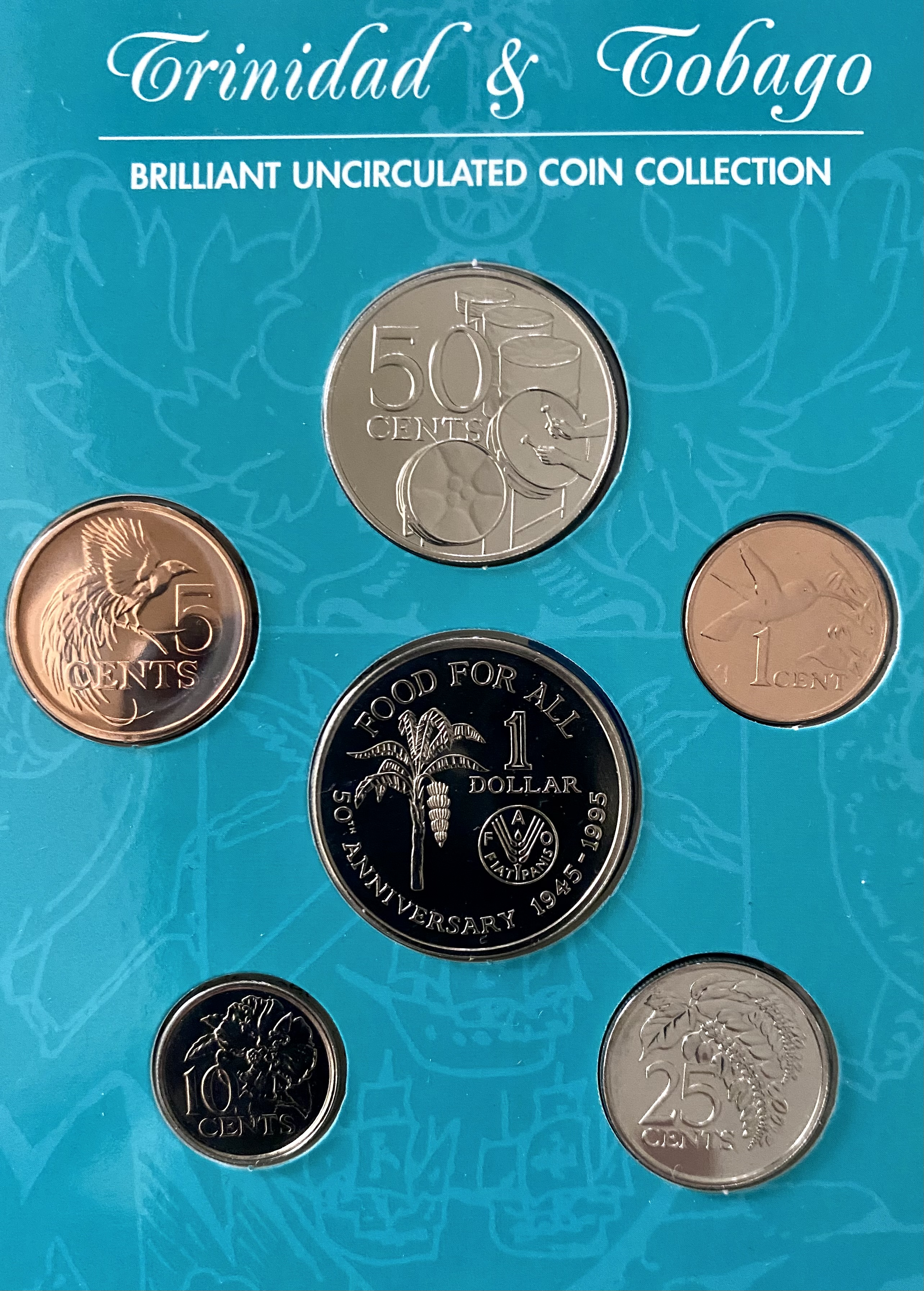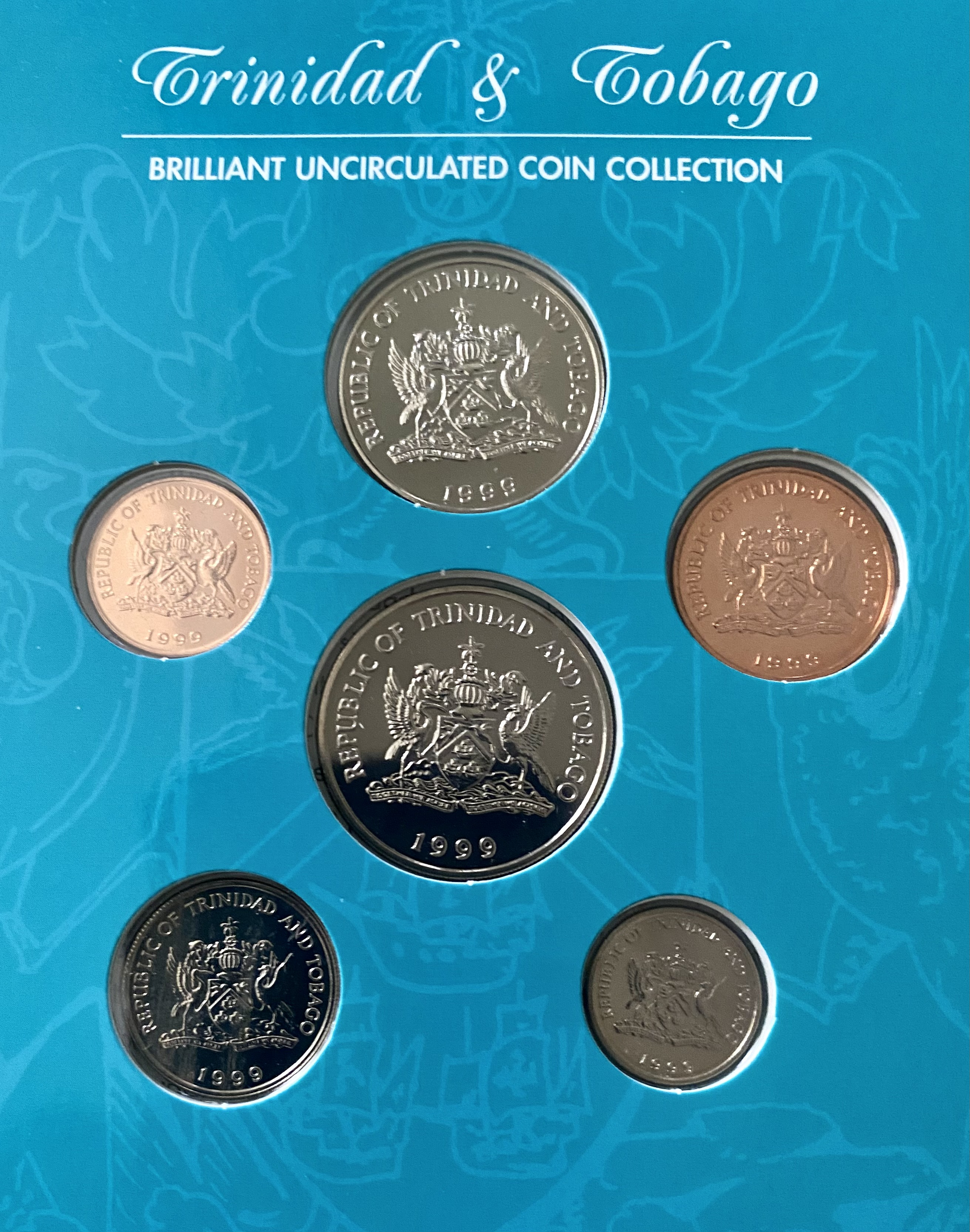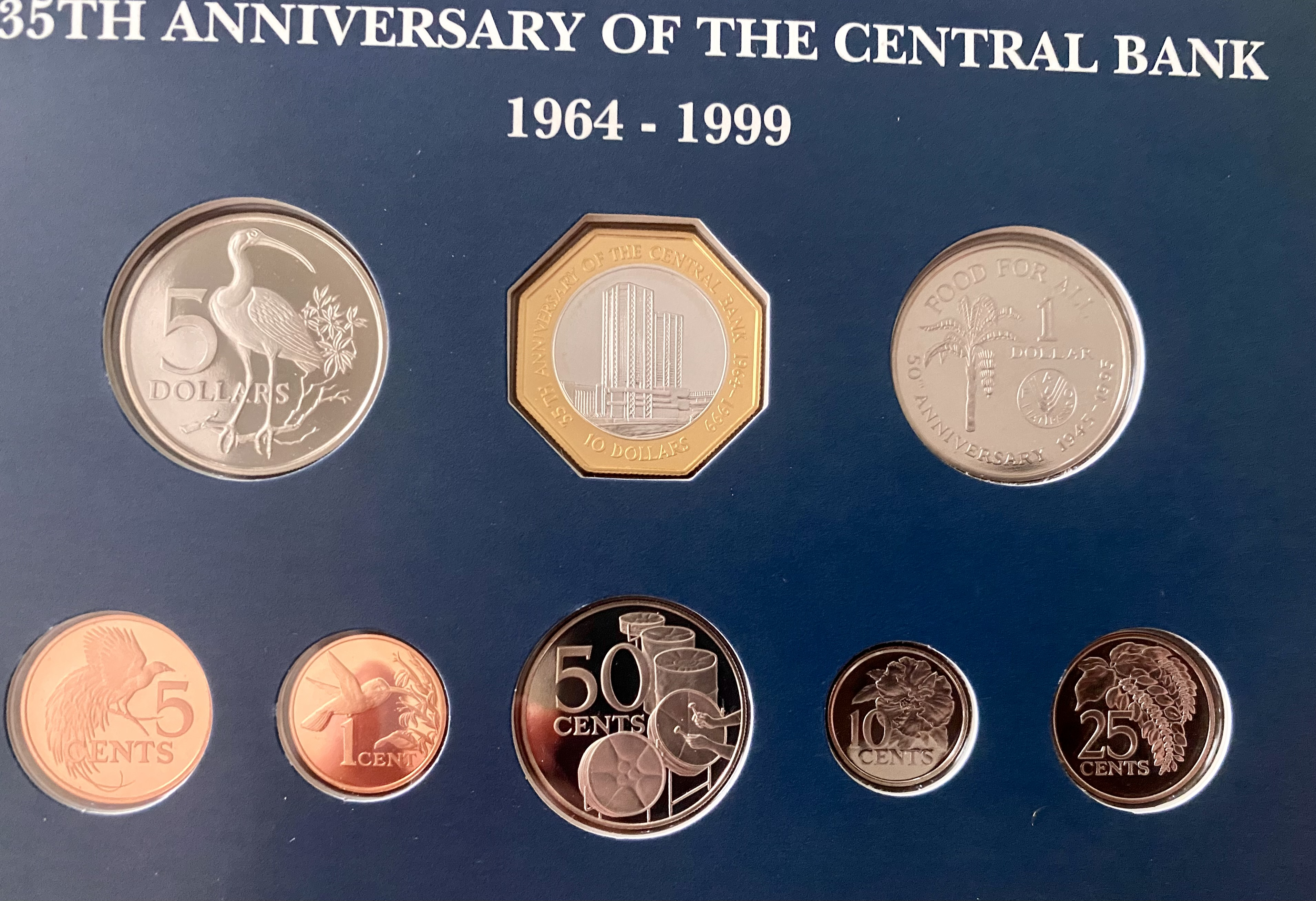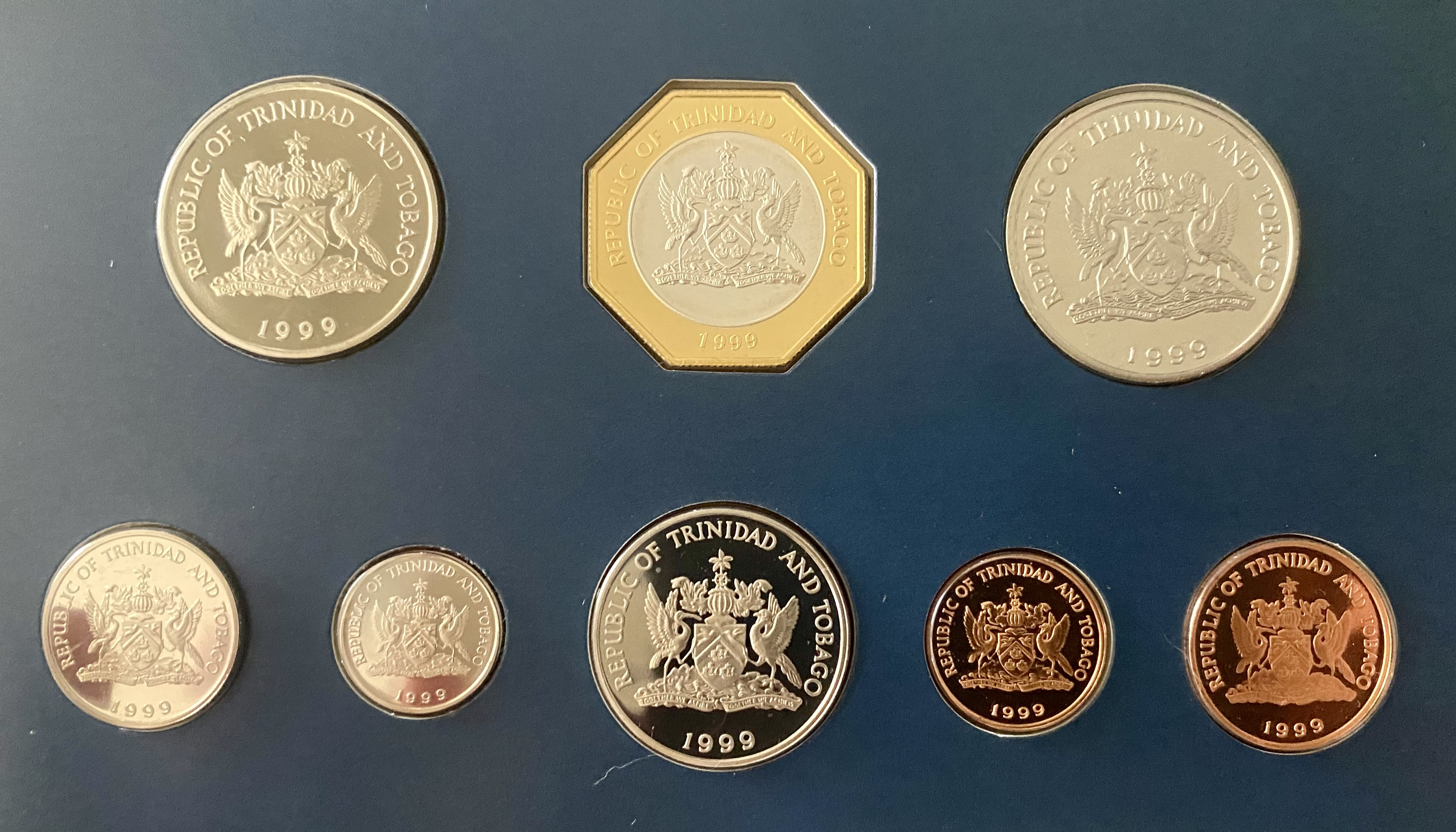Recent Coins - Trinidad 1999 as Illustrative Example
 7Jaguars
Posts: 7,819 ✭✭✭✭✭
7Jaguars
Posts: 7,819 ✭✭✭✭✭
I am choosing this as an illustration of the type of coins that hold my interest at least, and though exceedingly rare, can be found with diligence by those on a budget. I began collecting and acquiring these coins when I was in college as funds for collecting were extremely limited.
I was able to find very attractive and affordable coins that were very rare, even if demand was low. On many the demand has picked up considerably, and those with silver have blossomed from that perspective. And I was able to obtain quite a few of what are arguably very interesting coins. My point is that young or older collectors or others on restricted funds can obtain wonderful coins.
On with the "presentation":
Many modern coins can still be had as described in the lead-in with occasional exceptional status. Some sets, particularly of the "BU" type about to be shown were minted by the Royal Mint and others that might be of interest. Positives are they usually contain attractive coins, actual released mintages are many times VERY LOW making them a challenge to find, and they occasionally show up in unusual circumstances that keep a collector on on his/her toes. They usually are made to technically allow those that can not afford expensive proof versions in precious metals to obtain examples - but they seldom are recognised by the target audience and are available with little fanfare for a short while, and then the mint moves on to more pressing and up-to-date offerings, etc.
So with regards to the 1999 Trinidad coins, we know that a contract was filled by the Royal Mint for currency examples of the lower denomination (1c through 25c) coins that were duly struck and evidently delivered to the host country. But also struck were an outhorised 3,000 mintage proof sets of that year that also contained 50c, dollar, five dollar, and ten dollar coins. Probably many fewer than this were actually released to collector channels as they show up only very infrequently (about once every 3-4 years, or even less often on eBay).
But they also struck very prooflike BU sets of the coins 1c through dollar. There was no authorised mintage of these and they are not in catalogues as sets. Even the smaller denominations do not look like the currency versions and can not be confused. But of the larger 50c and dollar coins, it seems these were only available in these sets & have NEVER seen them sold in currency form despite them being listed in the defunct Krause, Numismaster derivative, NGC, Numista, etc. I will check in my misplaced Schon catalogue (which by the way is another source reference that has some useful information although extremely condensed with rice paper-like pages).
They are valued at a couple of dollars, but again try to find a 1999 uncirculated Trinidad 50c or dollar coins! Please let me know if you EVER find one. So the proofs are very scarce to rare but the unloved BU sets apparently very rare. One caveat is that it is possible some are hidden away on some shelf in the backroom at the Central Bank (of Trinidad and Tobago), but I tend to doubt this as this has been the case with many other similar coins and sets.....
Here are pictures of the 1999 Trinidad BU set, with a second set of the 1999 proof set:




Well, just Love coins, period.
Comments
Nice sets!
You mentioned some sets could be in the back room at the Central Bank… what are the chances that the Central Bank just released the coins into general circulation at some point thinking the unsold sets were simply not worth storing longer?
I dunno…
Experience the World through Numismatics...it's more than you can imagine.
Yes, that would be reasonable. I have not seen hide nor hair of such. I do have some friends down there, and one even worked in administrative capacity at the Central Bank but sadly with no recall of such coins which I took to be more of a nuisance. The 1984FM Trinidad specimen uncirculated set was known to be very scarce down there at the time but few at the Bank could get hold of one.
Well, just Love coins, period.
If the proof set mintage was actually 3000, something like this must have happened.
3000 is not a low number for a non-US set, especially for a county like this one. The mintage on most South Africa Union proof sets from 1947-1960 is 800 to 5000. (1952 and 1960 are higher.) Finding intact sets is a lot harder now, but only because South African collecting has a strong preference for slabbing. The individual coins aren't hard or that hard to find.
Mintage on earlier proof sets is 10 to 150, except for 1923 which is 1402. Except for 1923, these are seldom seen now intact, but 1944-1946 singles aren't that hard to find. (Heritage is selling a major collection in August.) 1932 Southern Rhodesia was 432 and 1935 New Zealand was 364. These coins (not sets) aren't hard to find either. Even the 1937 Southern Rhodesia (reported mintage 40) wasn't that hard to find. (I haven't looked for it in some time.)
Well, with all due respect I do not agree based on my observations of T&T. South Africa decidedly is not my area but I seem to recall the varied proof sets even with low mintage to show up more frequently than even the 1999 T&T proof set. I think my point was that, as an example, authorised mintages by the Royal Mint (at least) do not mean necessarily the number actually struck
So there is authorised mintage
Actual sets or coins struck
Actual sets or coins released
Actual number gone to secondary recipients (collectors, museums, dealers (not likely many of those in this case)
Net returns to the mint
Losses due to misstrikes or damaged, etc.
So the final number available to market may be as many as 3000 but evidence based on observation seems to point to substantially fewer.
The BU set would likely be decidedly scarcer.
Another example would be the 1994 Cook Islands coins struck by the ?Canberra Mint where we are virtuallycertain that the authorised mintages did NOT make it out to collector channels.
Or the 2002 Jamaica Proof Set struck by the Royal Mint with 500 authorised but actual struck was apparently 113 with likely net numbers to collector channels substantially fewer & estimated less than 50. - I have seen precisely one set in over 20 years,
Or go back to T&T specimen mint sets of 1984 not known to exist and not recognised until the discovery I posted several years ago.
Or the Belize specimen mint set of 1984 not known to exist for nearly 40 years with also only ONE known.
So the list of these types of coins goes on and on & my point was to present the 1999 Trinidad example. Also I would venture to guess, as was also my point, that these type of coins and sets are potentially available at much lower prices than US or South African or GB sets of similar rarity, not even mentioning the possible aesthetic quality of the coins.
Well, just Love coins, period.
I wasn't arguing or disagreeing with you.
If this 1999 proof set has an equivalent mintage to any of the South Africa sets I used as examples, it should be apparent it will be more difficult to buy due to the price difference. This is true of any coin generically. It's a lot more likely to sell in a venue (such as some random dealer) where virtually no one will be aware of it. The 1930 and 1932 South Africa sets with mintages of 10 and 12 are valued in the five figures. I've seen partial or full sets two or three times to my recollection, including the upcoming Heritage sale.
It's apparent the mintage cannot be 3000, unless the vast majority were or are hoarded or never released. Otherwise, it would be (relatively) easy to buy regardless of the price. 3000 isn't a low number, except to US collecting which considers easy to buy in multiple coins scarce or rare. It's a lot more "popular" (preferred), but the recent Swiss proof sets also have mintages below 3000.
Yes, not a comparison - except the rarity of the BU set. Lol
However, again my point was that these type of sets are potentially if found affordable, at least for now. This makes them available to those of limited resources. And that is the enjoyable bit.
I mean I have GB coins of greater rarity and value than even those SA you pointed out, but not the point of the post.
Some of the others I pointed out are reaching for the sky though - price wise.
Well, just Love coins, period.